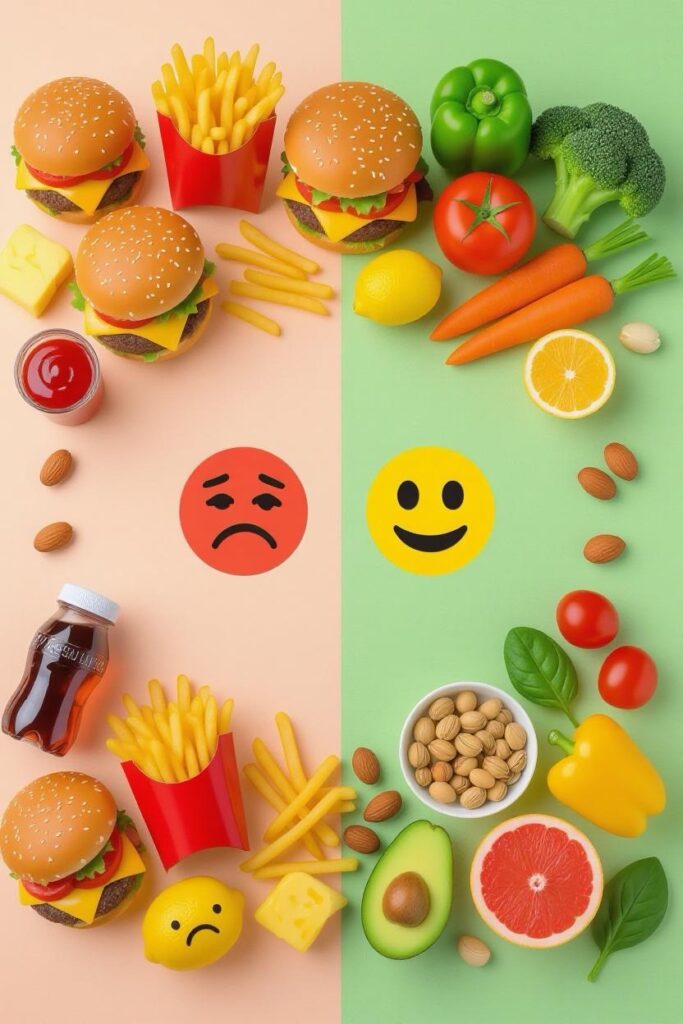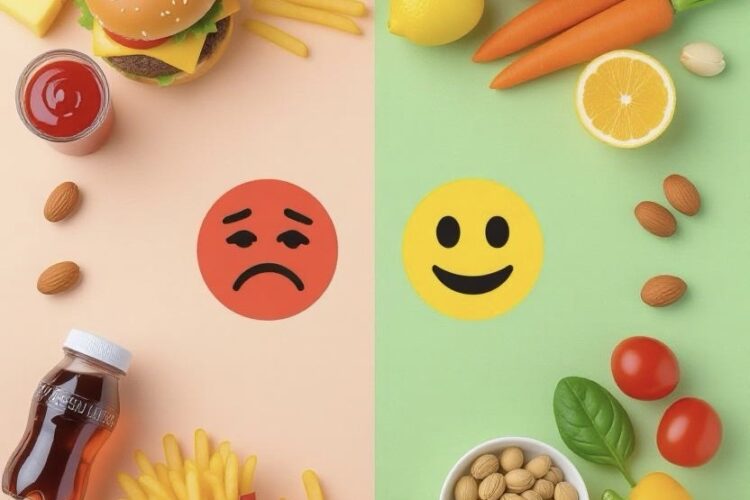Fast food and ultra-processed foods (UPFs) disrupt hunger hormones like ghrelin and leptin, making you feel hungrier and less satisfied, leading to overeating and weight gain. These hyperpalatable foods, high in additives and energy density, reduce satiety hormones PYY and GLP-1, while causing leptin resistance and elevated ghrelin. This hormonal imbalance, combined with a soft food matrix that speeds eating, overwhelms gut-brain signaling, promoting obesity and metabolic disease. Additives like BPA and gut microbiome changes worsen insulin resistance and inflammation. Studies show UPF diets increase calorie intake by 400-500 kcal daily, driving body fat gain. To counter this, eat whole foods, practice mindful eating, exercise, and sleep well to balance hormones and curb cravings. Limiting UPFs is key to preventing chronic diseases and maintaining healthy weight.
Long Version
The Impact of Fast Food and Ultra-Processed Foods on Hunger Hormones and Weight Gain
In today’s fast-paced world, fast food and ultra-processed foods (UPFs) dominate many diets, offering convenience but at a hidden cost. These hyperpalatable foods, often loaded with additives and engineered for supernormal appetitive properties, disrupt key physiological processes. They interfere with gut-brain signaling, leading to hormonal imbalance that amplifies hunger while diminishing satiety. This cascade promotes overeating, increased calorie intake, and energy intake, fueling weight gain, obesity, and metabolic disease. Drawing from rigorous research, including randomized controlled trials and inpatient studies, this article explores the mechanisms, evidence, and implications, providing a clear path to understanding and mitigating these effects.
Hormonal Disruptions: How UPFs Hijack Hunger and Fullness Signals
At the core of this issue are hormones like ghrelin, the hunger hormone, and leptin, the satiety hormone. Ghrelin levels rise before meals, signaling the brain to seek food, while leptin, produced by fat cells, curbs appetite by indicating sufficient energy stores. Fast food and UPFs dysregulate this balance, often causing ghrelin to remain elevated even after eating, while fostering leptin resistance where the body ignores satiety cues. This hormonal imbalance results in persistent appetite, delayed satiety, and hyperphagia—an uncontrollable urge to overeat.
Other key players include peptide YY (PYY), an appetite-suppressing hormone released from the gut, and glucagon-like peptide-1 (GLP-1), which enhances satiety and regulates blood sugar. Studies show that UPF consumption suppresses PYY and GLP-1 post-meal, reducing their protective effects against overeating. For instance, in controlled settings, participants on UPF diets exhibited higher ghrelin and lower PYY and GLP-1, correlating with increased ad libitum food intake.
Adiponectin, another hormone tied to insulin sensitivity, often decreases with chronic UPF intake, exacerbating insulin resistance. Thyroid hormones like total T3 (triiodothyronine) and free T4 (thyroxine) can also fluctuate, slowing metabolism and promoting adipogenesis—the formation of fat cells. Elevated free fatty acids from rapid digestion of these foods further contribute to oxidative stress and inflammation, marked by rising hsCRP (high-sensitivity C-reactive protein) levels, which perpetuate a cycle of metabolic disruption and chronic disease.
Cortisol, the stress hormone, spikes with UPF-heavy diets, especially those causing blood sugar spikes from refined carbs and sugars. This not only heightens hunger but links to emotional overeating and food addiction, where the brain’s reward system craves more despite adequate energy intake.
Underlying Mechanisms: From Mouth to Microbiome
The disruption begins with oro-sensory properties—the taste, texture, and smell that make fast food irresistible. UPFs are designed with a soft food matrix that reduces chewing frequency and eating rate, allowing quicker consumption and less time for satiety signaling to kick in. This leads to ad libitum intake far exceeding needs, as the gut-brain axis fails to register fullness promptly.
Additives and endocrine-disrupting chemicals like bisphenol A (BPA) leach from packaging or ingredients, interfering with hormone receptors and worsening insulin resistance. The high energy density of these processed diets means more calories per bite, bypassing natural controls on portion size.
Deeper still, UPFs alter the gut microbiome, favoring bacteria that promote inflammation and reduce production of satiety hormones like GLP-1. This microbial shift contributes to gut-brain signaling dysfunction, where signals for hunger overpower those for satisfaction, driving compulsive behaviors akin to food addiction.
Evidence from Scientific Studies: Proving the Link
Pivotal research underscores these effects. A landmark inpatient randomized controlled trial involved 20 adults consuming UPFs or unprocessed diets ad libitum for two weeks each in a crossover study. Despite matching for calories, macronutrients, and fiber, participants ate 500 kcal more daily on the UPF diet, leading to 0.9 kg weight gain versus loss on the unprocessed one. This hyperphagia stemmed from faster eating rates and hormonal shifts, with elevated ghrelin and reduced PYY.
Subsequent studies echo this. A Japanese crossover trial linked UPFs to reduced chewing frequency, boosting energy intake by over 400 kcal daily and causing body fat mass increases. Another UK trial in overweight adults found UPFs, even when aligned with healthy guidelines, prompted greater calorie intake and cardiometabolic risks compared to minimally processed foods.
Population data reinforces: Youths consuming high UPFs show disrupted sex hormones and higher obesity rates, tied to endocrine disruptors. In emotional stress contexts, UPFs exacerbate cortisol-driven overeating, linking to binge eating disorder and metabolic disease.
Broader Health Implications: Beyond Weight Gain
The consequences extend far. Persistent overeating from these foods accelerates obesity, where body fat mass accumulates rapidly, heightening risks for insulin resistance, type 2 diabetes, and cardiovascular issues. Inflammation from oxidative stress and hsCRP elevation contributes to chronic disease, while gut microbiome imbalances may worsen mental health via the gut-brain axis.
Food addiction emerges as a real concern, with hyperpalatable foods hijacking reward pathways, similar to substances, leading to compulsive ad libitum intake. In children, early UPF exposure shapes lifelong preferences, increasing energy density in diets and predisposing to metabolic disease.
Strategies for Mitigation: Reclaiming Control
Shifting to a minimally processed diet restores hormonal balance. Prioritize whole foods to enhance PYY and GLP-1 release, normalize ghrelin, and improve leptin sensitivity. Mindful eating boosts chewing frequency, aiding satiety signaling. Avoid BPA-laden packaging and additives to minimize endocrine-disrupting chemicals.
Exercise and sleep regulate cortisol and thyroid hormones, countering oxidative stress. Monitoring blood sugar spikes through balanced meals prevents insulin resistance cycles.
In conclusion, fast food and UPFs drive a vicious cycle of hormonal imbalance, overeating, and weight gain through intricate mechanisms involving ghrelin, leptin, PYY, GLP-1, and more. Backed by inpatient studies, crossover trials, and biomarkers like adiponectin and hsCRP, the evidence is clear: limiting these foods is key to preventing obesity, metabolic disease, and chronic ills. By understanding these dynamics, individuals can make informed choices for lasting health.

Eat real food. Don’t let your cravings run the show.
Hashtags For Social Media
#ultraprocessedfoods #fastfoodeffects #hungerhormones #leptinresistance #ghrelin #healthyeatingtips #mindfuleating #weightgainprevention #obesityprevention #wholefoodsnotjunk #nutritiontips #eatforhealth #metabolichealth #hormonebalance #cravingscontrol #healthylifestylejourney #antiinflammationdiet #guthealthmatters #processedfoodawareness #eatcleanbewell #foodandhormones #bodyfatloss #wellnesshabits #healthylivingtips #stopovereating #nutritionalwellness #fastfoodreality #healthconscious #fitnesstipsandtricks #balancednutrition #chronicdiseaseprevention
Related Questions, Words, Phrases
how do fast food and processed foods affect hunger hormones | can ultra-processed foods cause weight gain through hormonal changes | why do hyperpalatable foods make me hungrier | how does fast food impact leptin and ghrelin | what foods disrupt satiety hormones pyy and glp-1 | why do additives in processed foods affect appetite | can eating junk food lead to leptin resistance | how does soft food texture promote overeating | what is the link between ultra-processed foods and obesity | do fast foods increase calorie intake without feeling full | how does the gut microbiome react to ultra-processed foods | can bpa in food packaging affect insulin sensitivity | why do processed snacks make it hard to feel satisfied | how do UPFs change hunger signals in the brain | what hormones are affected by energy-dense foods | how can eating whole foods restore hunger hormone balance | why do soft foods make you eat faster | what is the effect of additives on inflammation and metabolism | can ultra-processed diets lead to metabolic disease | how does fast food consumption alter gut-brain signaling | do hyperpalatable foods override natural satiety cues | why does junk food trigger cravings | how much weight gain is linked to UPF diets | can mindful eating counteract hormone imbalances from processed foods | what strategies reduce overeating from fast food | how do satiety hormones like pyy and glp-1 work | why does leptin resistance cause continued hunger | how do ultra-processed foods influence blood sugar and insulin | what role does exercise play in balancing hunger hormones | can sleep improve leptin and ghrelin levels | how does calorie-dense processed food affect metabolism | why do additives in packaged foods increase inflammation | how can limiting UPFs prevent chronic disease | what is the connection between UPFs and fat gain | how do processed foods affect cravings and appetite regulation






